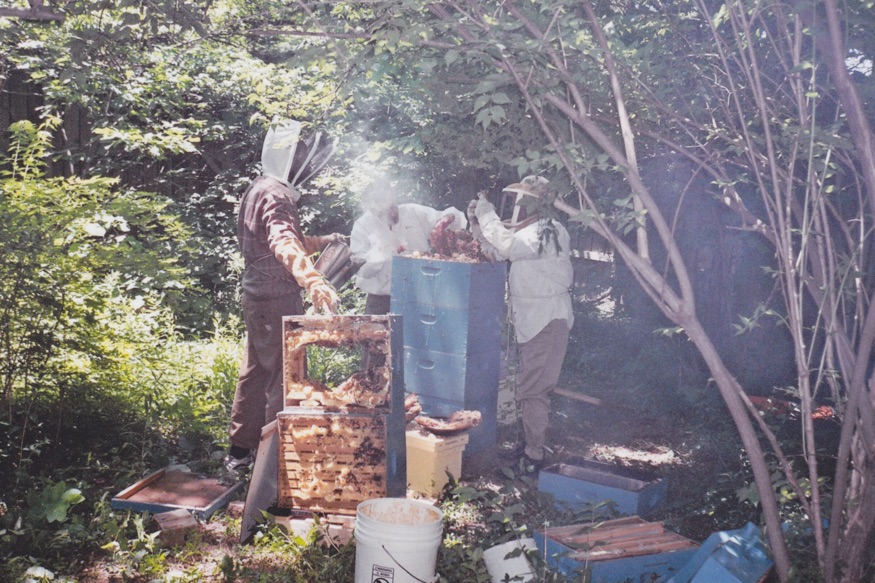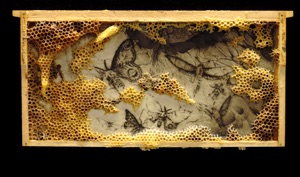
Bee Keepers Gallery

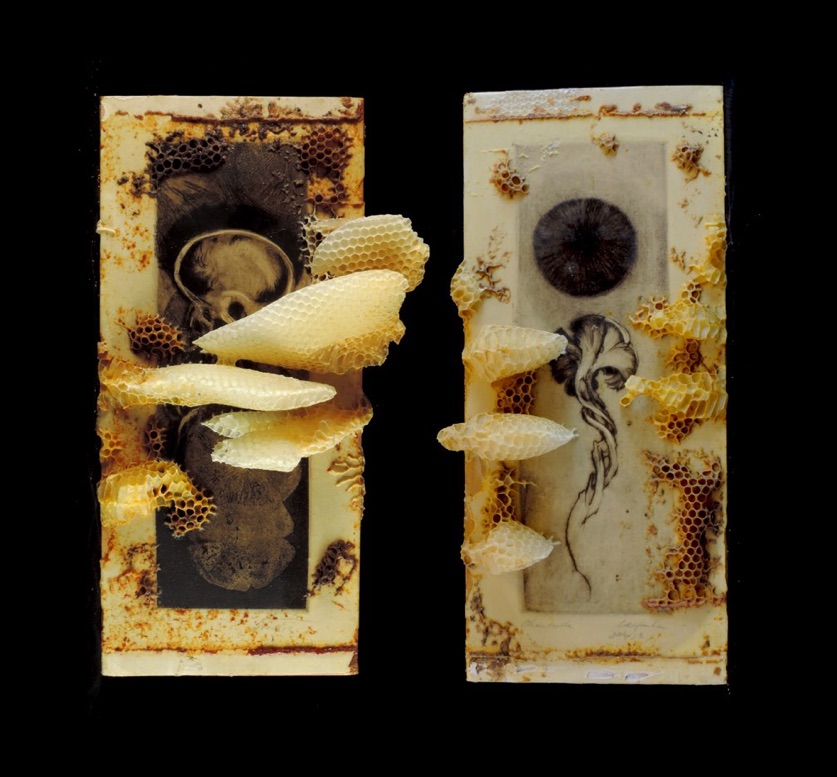

Bee embalmed




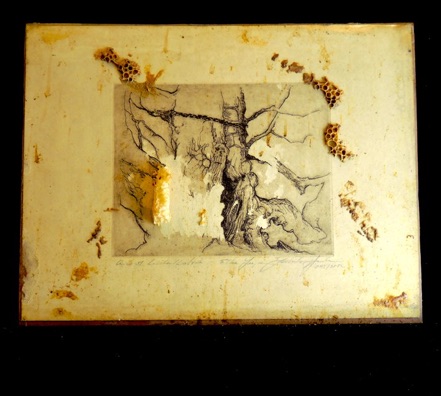


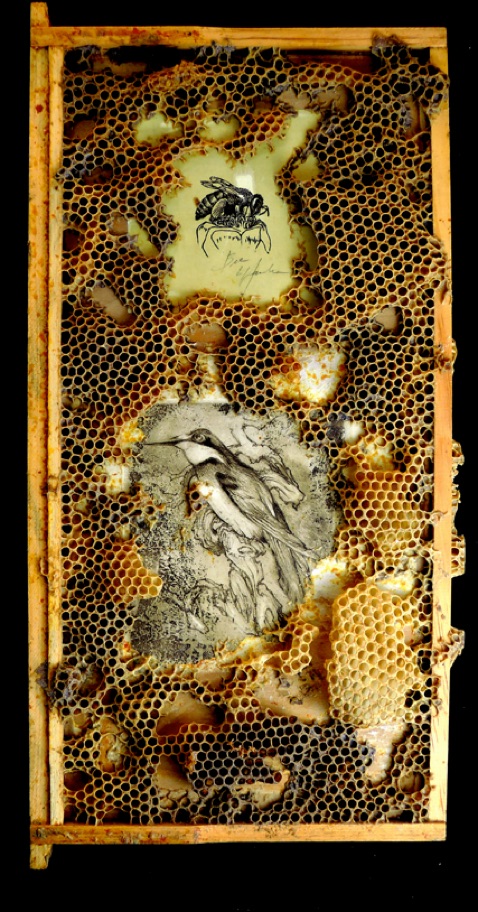


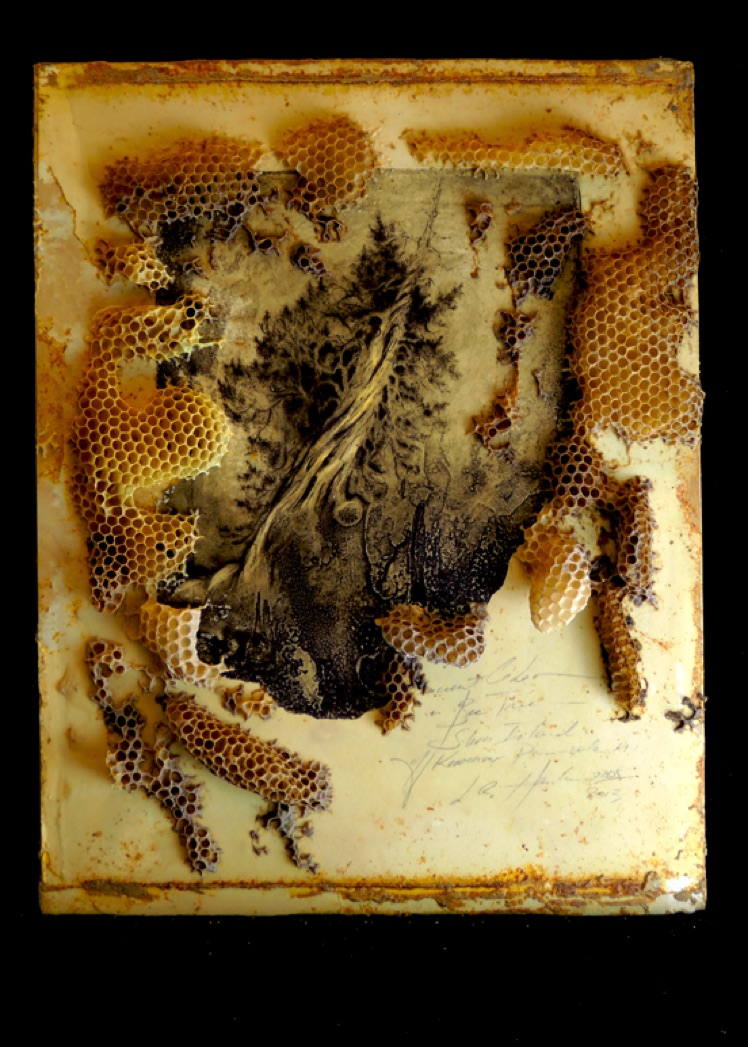
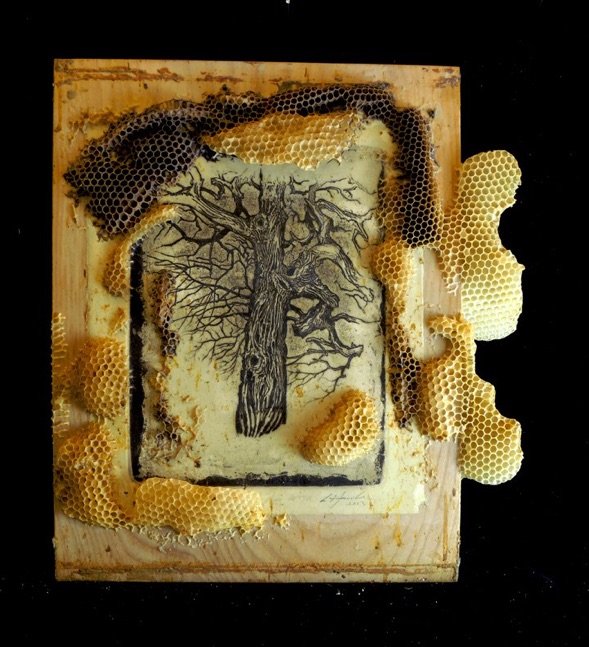
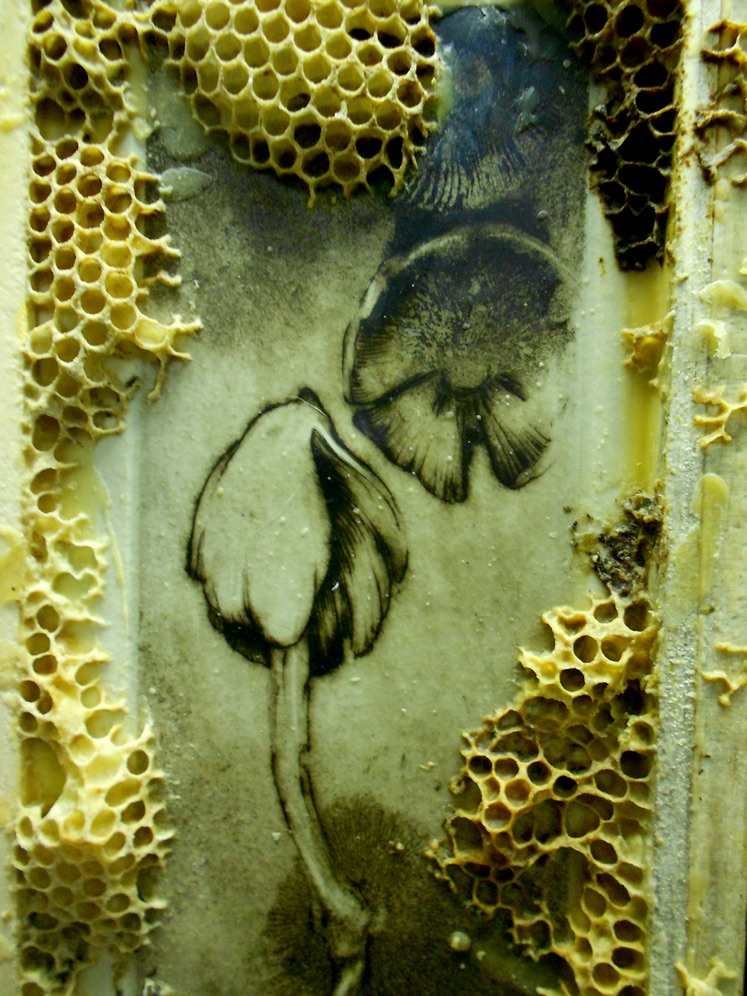
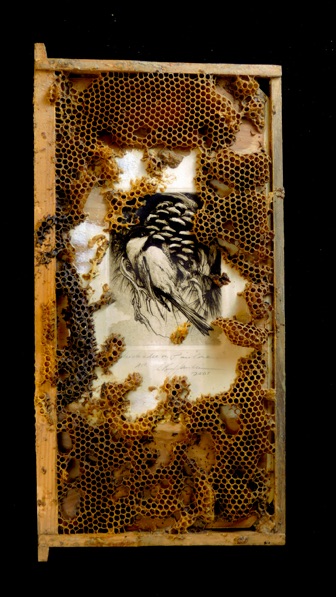
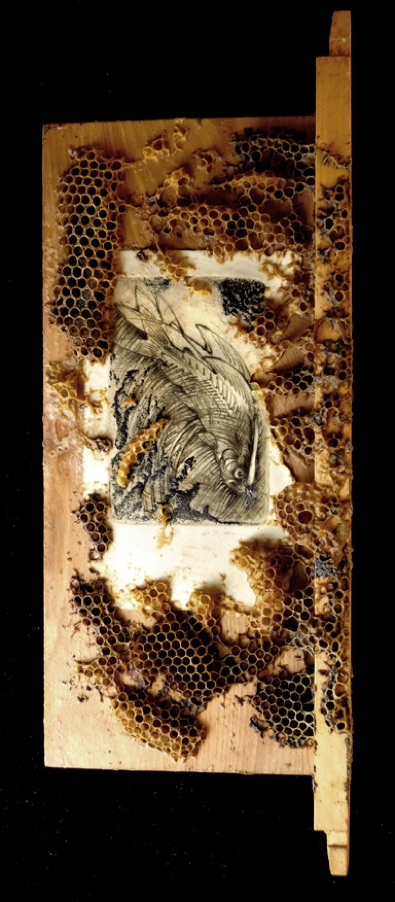
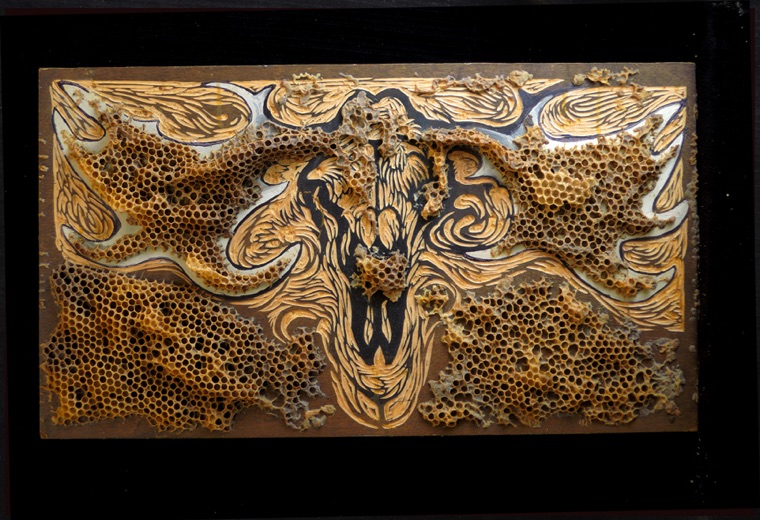

collaborators - worker bees bringing in the harvest
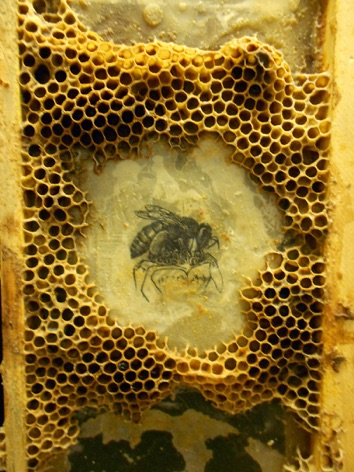
Gifts of Forest & Field
Fairy Rings & Honey
Bee Eater -
etching with drypoint

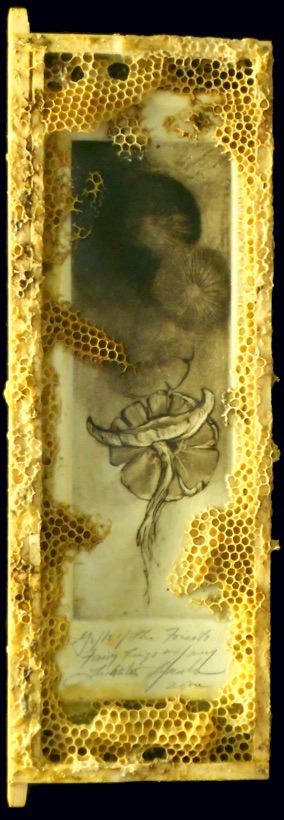
So then; is this collaboration of me and my bees a matter of exploitation, superficial affectation or perhaps conceptual art? Am I playing with mere chance or allowing the free will of some other sentient being to enter into my creative process? I am unsure, but it seems worth examining.

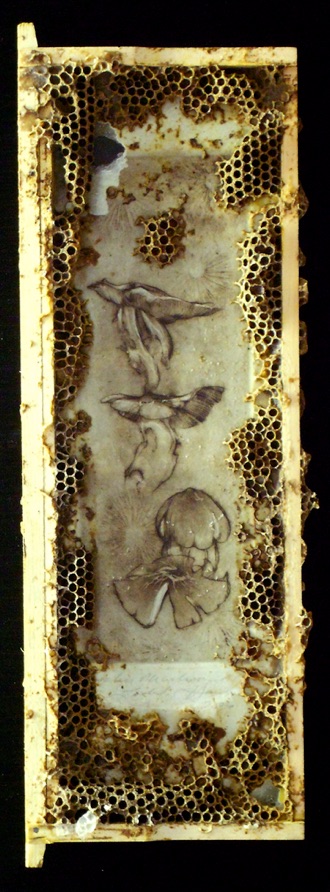

In the great cycle of being, creation and decomposition are but two sides of one coin. Bees pollinate and plants reconfigure the molecules that soil fungi pry loose from the dead and release back into the system. Of course, bees are in trouble and Bee Trees are increasingly rare. Crops are now threatened by a paucity of pollinators. even the once resilient decomposing side of the cycle is now weakened by pernicious pollutants that have no obvious chinks in their armor and thus are not easily broken down.
Esoteric traditions speak of an Akashic Record in which all things are recorded and accessible to those who’ve earned the right of entry. Here you see a fanciful entry in that book of records, opened to the page of decomposers and pollinators.
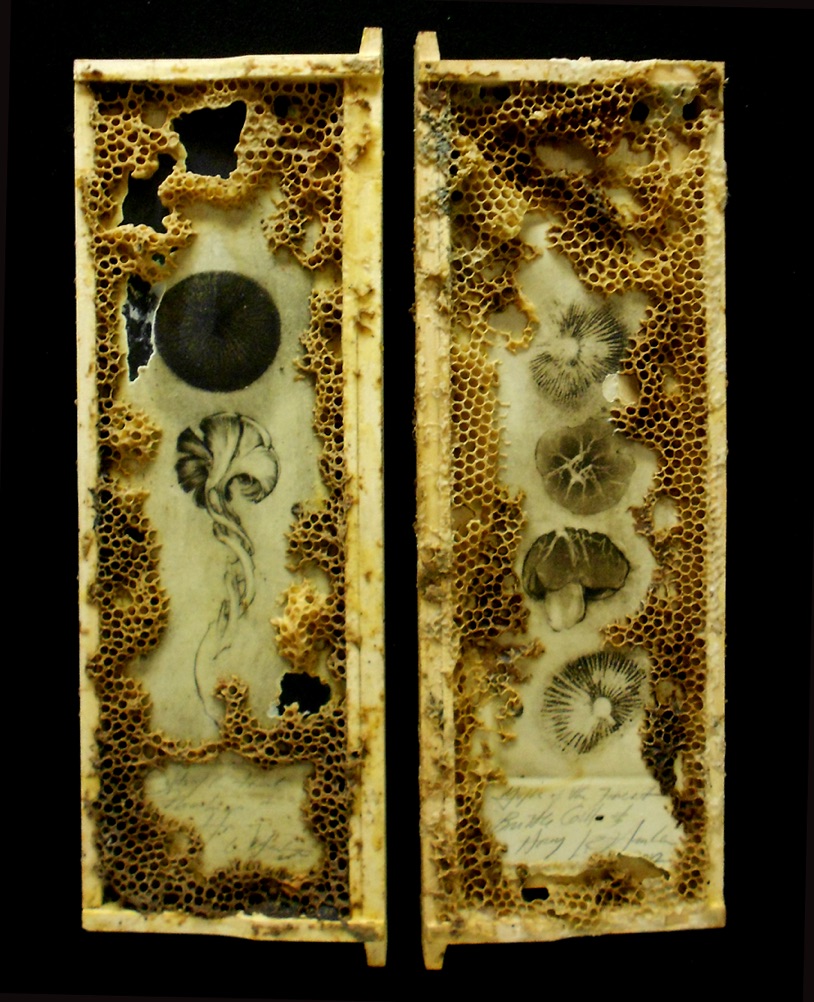
I’d like to do something about all of that, but I am neither scientist nor politician. I am an artist and a beekeeper – thus an active dues-paying member of two ancient esoteric brotherhoods. So I draw pictures. When I do so, I feel in touch with creation and most fully alive. When I open a hive, it isn‘t so different. My attention is clearly upon the sound of 30,000 buzzing creatures, each with a venom-filled stinger, getting increasingly disturbed as I reach in and pull out their winter stores. I read the ledger of their lives in frame after frame of brood and honey in order to manage the hive. Since I rarely wear much more than a T-shirt and shorts, I must also be sensitive to their communications or suffer the consequences. In both of these callings, as artist and as keeper of the bees, I am entering primordial mysterious worlds that are at once alluring, and potentially dangerous.
You see before you my two interests combined: The etchings are made in the usual way, but then I insert them into the hive for bees to add the next layer. Sometimes they chew up my artwork and pitch it out of the hive alongside their excrement and dead. At other times they join forces with me to co-create. If I cover my work with a thin translucent layer of melted bee’s wax, it smells familiar and they tend to accept it. If I attach some burr comb, they seem to like that even better and often initiate work right there – adding to it or recycling it and moving it around. Let them go long enough and they’ll cover it all with capped honeycomb or perhaps they’ll chew it all up. Take it out at just the right moment and the results can be an unpredictable collaboration of sublime beauty.
Bee-keeping may excite me, but there is nothing new about any of this. The people who walk into my studio and are charmed by the bees’ wax all over the artwork, already know about Darwin and chance; free will and determinism – genetics as destiny; cave art and the domestication of farm animals and so on. They do not need to be told – yet I see them respond. It is as if they were seeing the world anew. Smiles come to their faces and it’s all they can do to behave as properly disciplined art connoisseurs and not touch the delicate vulnerable surfaces or taste the art. They do tend to immerse their noses in the art and inhale deeply. It clearly elicits interest while meaning as little as a Bach partita - or perhaps as much. It feels eminently successful, but I am still unsure why this should be so.
Duke Ellington once told a music critic; “ If it sounds good, it is good.” I may be moved to make something because I have something to say, but I am unsure how much of that ever gets communicated – especially with the passage of decades and centuries. Today’s big issue is, after all, yesterday’s news – at best, quickly and quaintly dated. Like getting excited over issues of Tammany Hall or the Red Scare. Art on the other hand, when at its best, is timeless. So, I seem to have gone on verbal walkabout and come back full circle. If it’s a beautiful drawing that moves us in ways we hardly know how to categorize or describe - why isn’t that good enough. Perhaps indeed it is. And if the story behind it is intriguing – great. How about that?

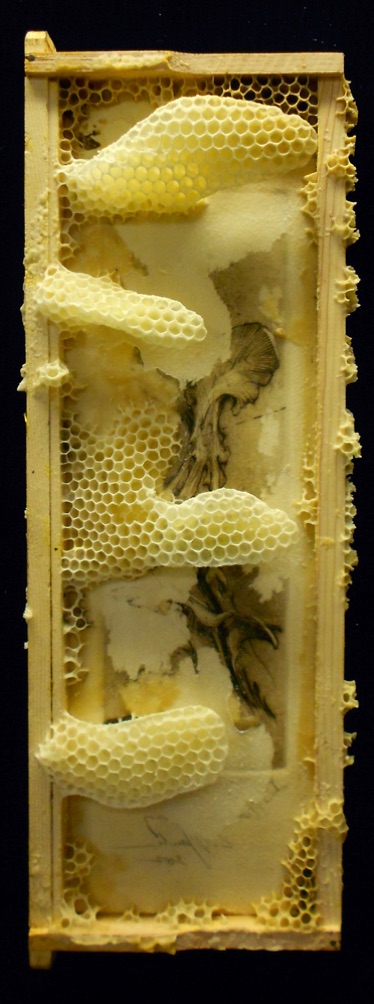
In the great cycle of being, creation and decomposition are but two sides of one coin. Bees pollinate and plants reconfigure the molecules that soil fungi pry loose from the dead and release back into the system. Of course, bees are in trouble and Bee Trees are increasingly rare. Crops are now threatened by a paucity of pollinators. even the once resilient decomposing side of the cycle is now weakened by pernicious pollutants that have no obvious chinks in their armor and thus are not easily broken down.
The oldest documented profession we know is bee keeping, depicted in a neolithic cave painting in northern Spain – older than the domestication of dogs, cows or sheep. It’s right there at the center of our most ancient social structures. And the ambiguities inhering in those activities - they too shout for attention; invade the hive and get sweetness or stingers; you feed and protect the lambs one day and slaughter them the next. These ambiguous activities we indulge in are at the heart of any meaning to be derived from art. Yet the question still remains about the art I’ve made with the help of bees; “does it mean anything to have added the bee’s wax?”
Earthball Fungus embalmed by bees
From the Book of Records:
Script and verse Symbioses and interspecies collaborations:
Reflections on Pollinators and decomposers.
Kastires Oak- Latgale, Latvia
Studio work and what the well dressed bee-keeping artist is wearing these days
Deep root - close up
Oyster Mushrooms Chantrelles
Bee - wood engraving
designed as Mead label for my father Dr. L J Hanka
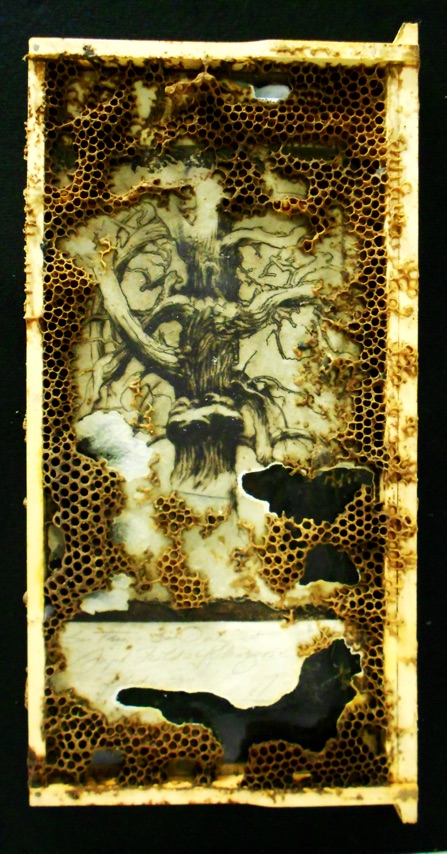
ç
I only got one quick drawing of the great Bur Oak at Angel Field. I thought I’d have all the time in the
I only got one quick drawing of the great Bur Oak at Angel Field. I thought I’d have all the time in the world to document this great old tree - that I would get over there on a nice day with my copper plates sanded and grounded just so, my mood contemplative and everything in tune. But then one day I was driving by and it was gone. No public discourse, no warning – just somebody’s summary executive decision to butcher the elder tree. Chip it and get it out of there before anybody notices or expresses a contrary opinion.
I used that one drawing to arrive at an etching by which to remember the old tree. Several trial proofs have gone into my bee hives to see how the bees might build upon and enhance the etching. I am encouraged to see that the pinhead-sized brain of a bee, brought to bear on the task, only excavated around the tree and therefore quite clearly cleaves to a far higher standard of design than do the architects of the new field house.
world to document this great old tree - that I would get over there on a nice day with my copper plates sanded and grounded just so, my mood contemplative and everything in tune. But then one day I was driving by and it was gone. No public discourse, no warning – just somebody’s summary executive decision to butcher the elder tree. Chip it and get it out of there before anybody notices or expresses a contrary opinion.
I used that one drawing to arrive at an etching by which to remember the old tree. Several trial proofs have gone into my bee hives to see how the bees might build upon and enhance the etching. I am encouraged to see that the pinhead-sized brain of a bee, brought to bear on the task, only excavated around the tree and therefore quite clearly cleaves to a far higher standard of design than do the architects of the new field house.
As an alumnus of Kalamazoo College it is hard to stomach that my Alma Mater was so cavalier as to trash one of the greatest Bur Oaks in Kalamazoo – and to what end? Apparently the roots of the living being got into the way of drainage plans being drawn up by some wunderkind in the penthouse suite of some Chicago architectural firm. Life was in the way of their abstract idea of a perfect football skirmish field. Bad enough when University of Michigan or Penn State sacrifice ethics and aesthetics for Football, but Kalamazoo College? What in heaven’s name for? Who cares how the Hornets did an hour after home-coming? Certainly not the students or their tuition paying parents. The players all read and write – usually quite well. They don’t even require special care facilities to keep them sober before kick-off time, as do the hulks on big-ten teams. Typically they graduate and eventually practice as dentists and lawyers - good ones - people whom you’d actually trust with your health or legal issues. What is wrong with that and why does it need to be improved upon? And how is the destruction of a beautiful old tree any kind of an improvement?
I only got one quick drawing of the great Bur Oak at Angel Field. I thought I’d have all the time in the world to document this great old tree - that I would get over there on a nice day with my copper plates sanded and grounded just so, my mood contemplative and everything in tune. But then one day I was driving by and it was gone. No public discourse, no warning – just somebody’s summary executive decision to butcher the elder tree. Chip it and get it out of there before anybody notices or expresses a contrary opinion.
I used that one drawing to arrive at an etching by which to remember the old tree. Several trial proofs have gone into my bee hives to see how the bees might build upon and enhance the etching. I am encouraged to see that the pinhead-sized brain of a bee, brought to bear on the task, only excavated around the tree and therefore quite clearly cleaves to a far higher standard of design than do the architects of the new field house.
Bur Oak at Angel Field
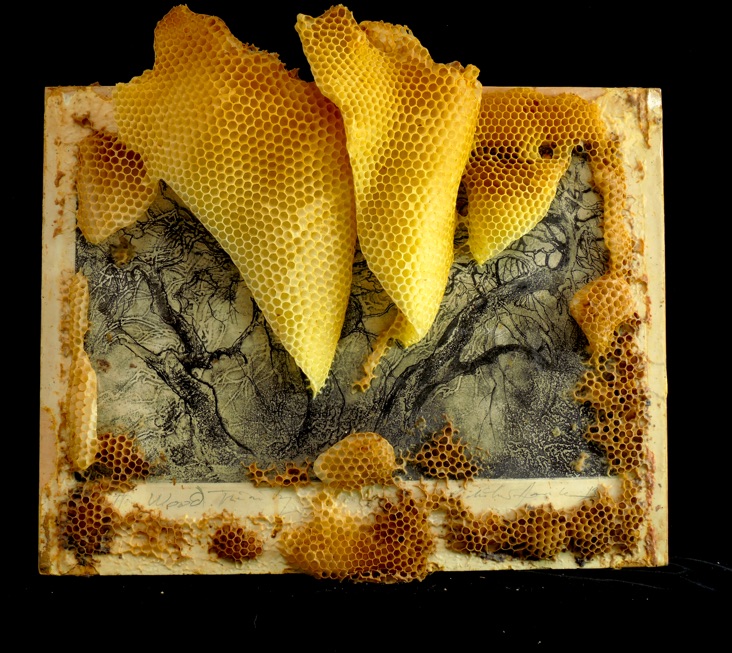
Sometimes it seems they like to color in between the lines


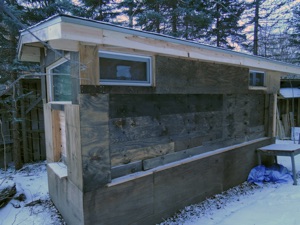
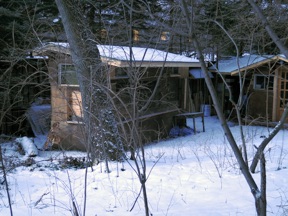


And where do bees live in the winter and what do they do for all those cold months when there are no flowering plants?
Well these days a gigantic portion of them die and bee-keepers go bankrupt and crops go unpollinated...but that isn’t what you were asking was it? Those beekeepers who still have the stomach to begin again, buy bees from someplace down south and hope to be lucky and not import africanized bees or snot brood or nosema or weak queens that have been pre-poisoned pollinating the Almond orchards of California. That is indeed a selling point for those California bee-keepers marketing packaged bees: Never seen the almond crop – a guarantor of better health.
Even so, the lucky buyers of out of state bees, who receive healthy bees, still get creatures that are not cold adapted and which rarely survive the next winter. Their drones get loose in the environment and breed with local queens and thus wreak havoc with the breeding efforts of northern beekeepers trying to breed hardier bees. It’s a mess – no bout a doubt it.
But – in the best of all possible unpolluted worlds somewhere far from our shores or in some forgotten backwater wilderness area – perhaps in the good old days that pale into the memory banks of those born well before the second World war – in those good old days when crops were organic and the food industry wasn’t actively engaged in the current bee genocide and pouring ever new toxic substances on food – in that best of all possible worlds, bees just go into their hives for a few months to wait out the weather. They form a ball of living creatures surrounding the queen and they eat the honey they gathered and stored for the winter and generate heat until the snows melt away and the sun regains its strength and the first Elms and Maples begin to blossom. Bees that emerge in spring have been born and raised in the dark and are seeing the out of doors for the first time. The fall bees are dead and replaced by new ones. Only the queen has survived from last year.
Since we live in today’s world and not in the good old days, those of us still keeping bees (about half of what it used to be) try our best to second guess chemically and industrially impacted biology and come up with ways to make it easier on the already stressed creatures to survive. We treat them with stuff that hopefully kills their parasites and controls diseases without tainting the honey or hurting the bees. We come up with ways that make life easier for creatures who used to overwinter in the northern states and Canada problem free and do so in the wild without any help at all. Think back a bit and try to recall how many bee trees you’ve seen lately - I look for them and its rare to find one any more. If I do, it’s almost invariably a swarm hive escaped from a nearby bee-keeper and not an old overwintering hive.
I was recently visiting friends in the Czech Republic who had bees and noted with interest that they do not just keep their bees outside in boxes and exposed to the weather like most Americans do. They build apiaries to house their bees which are well protected from the weather and where ones investment in hives will not deteriorate from getting wet and drying out under a blistering sun or alternately freezing and thawing – and – most importantly, where the cold gusts of Siberian winds sweeping down off the plains of Poland and Ukraine aren’t driving down the temperatures inside the hives to lethal levels. I started asking people and quickly realized that this is just the way it’s always been done and why would you do it differently - why fight with the successes of what our ancestors already discovered years ago? when you look at websites from Ukraine or Lithuania where they have traditional bee-keeping museums with all manner of old time decorative hives and apiaries - you see that these far colder places do just that - but in spades. Hmmm.... may well be something to learn there from somebody else’s successes in places where bees are actually native and the tradition of beekeeping has ancient roots - do ya think?
Come into our parlor
Pull up a frame and chew the wax with us
Home sweet home
Bee keepers compound
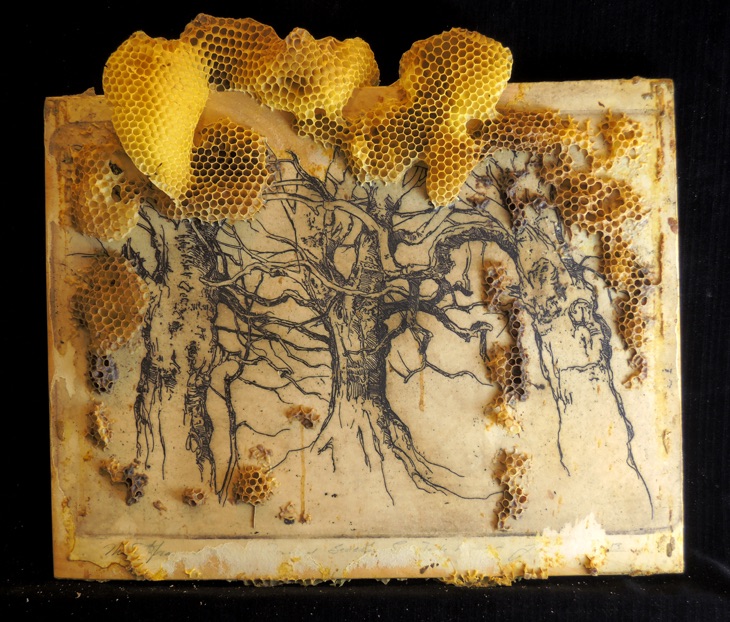
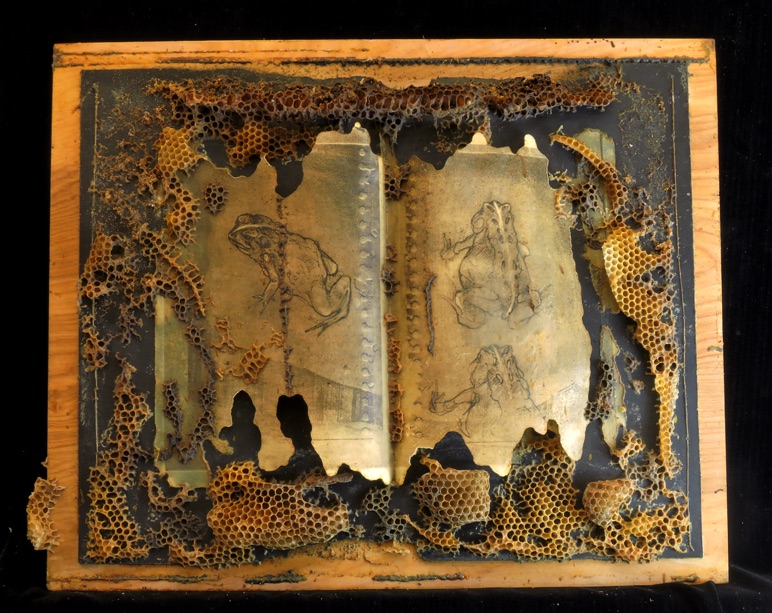
So then that has been my project of the year: a Bee Palace, which at that point, was merely a pragmatic building designed to house about 20 hives, up above ground , well insulated with solar gain being a part of the design and mouse exclusion built right in – but which will also took it’s impetus from Ukrainian beekeepers and the artful designs they give them ...
....something one can now see here at my house without having to keep an peeled for snipers or incoming mortar shells. And, next door is a small honey house for extraction and keeping the wax and honey out of the kitchen. That too has very practical applications in the spousal stress reduction department.

That’s a challenge. Art clearly must have meaning to move past mere decoration and yet art that is overly didactic is pretty deadly. And art that merely illustrates a concept or a theory – is deadlier yet. How many dark empty rooms with video monitors have we all walked past in the contemporary wing of a museum with thoughts of not having come there to watch TV – thank you. My answer to the internal art cricket chirping away in there, seems more easily to be derived from the world of music, where we tolerate far more ambiguity than elsewhere. What does a Mozart sonata mean? It is clearly art and moves people, but its universality seems to be a function of its artifice. The structure is self-evidently informed by intellect, while lacking in any obvious meaning. That’s an odd sort of involuted, reasoning. The contradictions seem so peculiar as to almost be the point – that art has to do with ambiguity rather than clarity. If it’s clear enough to be put in an essay, then by all means make it an essay and just leave us be to enjoy our music. The string quartet has structure and is far from an orchestrated accident. There is generally even some room for individual interpretation – but meaning? I don’t know what it means, though I tend to like these very musical forms. There is something similar to all that in my working with bees.
Chance and necessity are the twin foundations of Darwinian evolution – the ultimate creativity. What artist doesn’t aspire to working with divine and cosmic forces – with the bedrock of evolution or creation? Things happen as they must – as the dance of the DNA dictates and as pure raw survival cements into place. You set up your experiment and the immutable laws of causality are set into motion. John Cage and many others have set about making art that incorporates chance. Elegant notions about chance and causality working hand in hand to create beauty and meaning, like it happens in nature - yet who wants to actually listen to John Cage? Too theoretical, when you just want to sit down with a beer and enjoy some good music – something else, something that isn't a chore to listen to - right?
To be even-handed, here’s an ancient Bur oak I drew and committed to an etching plate one fall day . Within a few weeks it had been chopped down without warning, without consultation. A heritage tree within Kalamazoo and one of few with that stature. The town is impoverished on the whim of somebody from the ranks of the militantly ignorant at nearby Western Michigan University. They were apparently clearing the ground in preparation for the demolition of the historic East Campus of the university from 1903. Those original buildings were of course the only worthy architecture to be found anywhere on campus or much of anywhere else in town for that matter. I suppose they served as a continual reminder that current architectural practices were not measuring up well to an older standard - so it and the trees all had to go.

I recall talking to the crew demolishing the old buildings at East Campus and being told that they were so well constructed that it took absolutely herculean efforts to break them up and remove them. The workmen hired to do the dirty deed were incredulous that somebody would have such excellent workmanship demolished when it had been that had been so evidently been made for top dollar and intended to last as a legacy.
Cottonwood Trinity embalmed
Linden

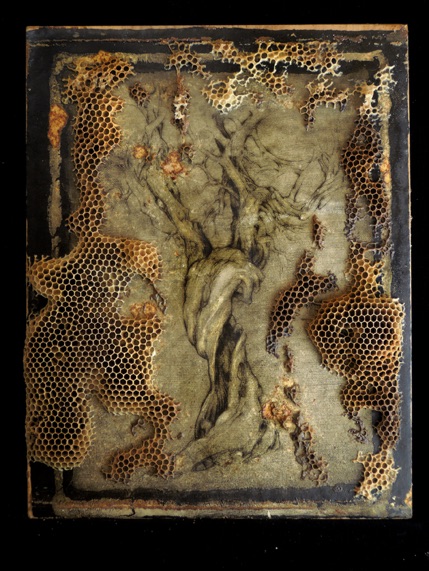
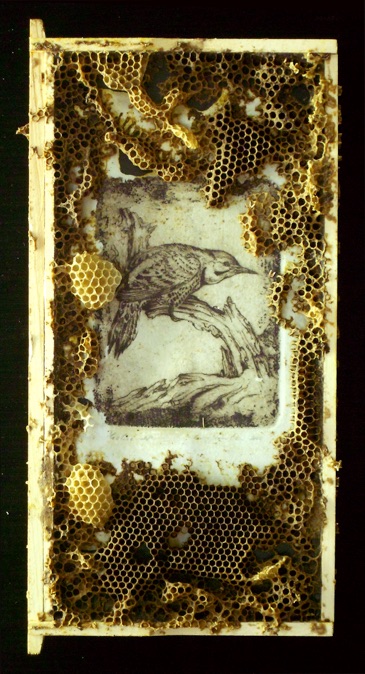
Flicker embalmed
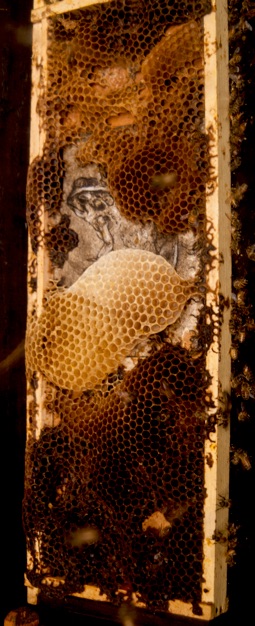
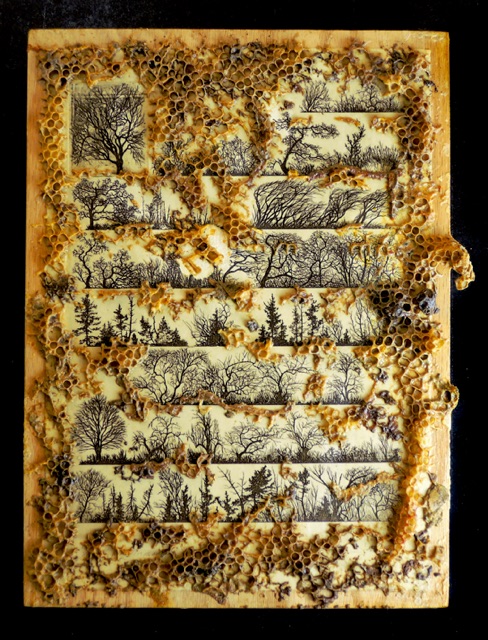
Bee & Bee eater

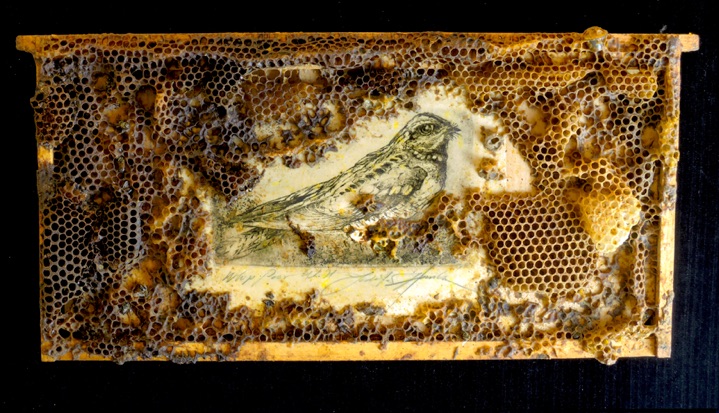
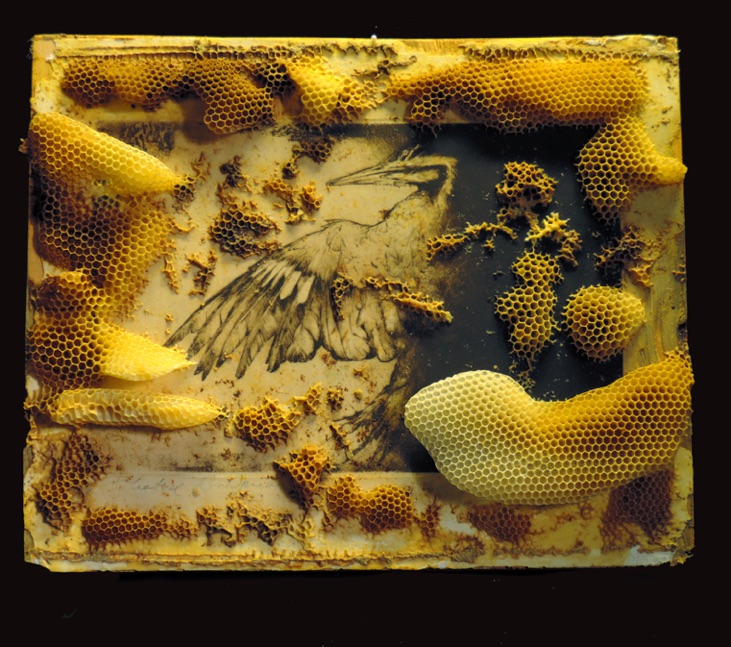
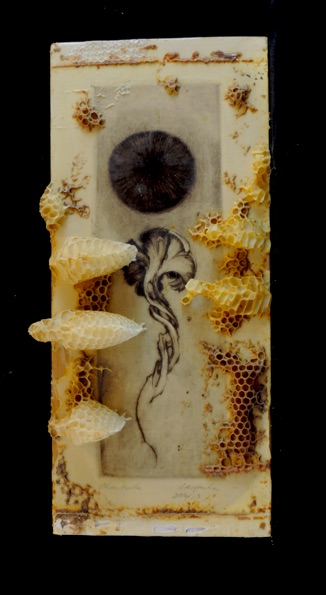
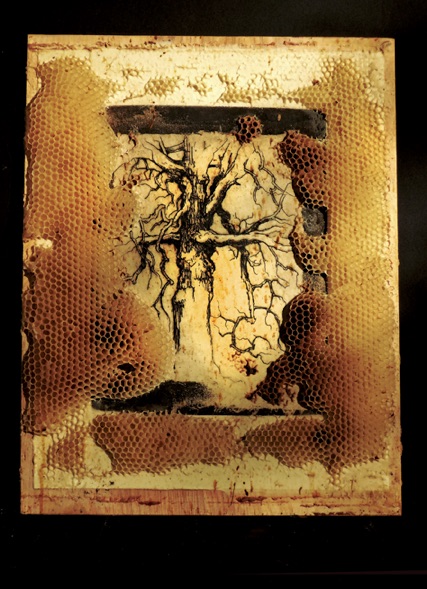
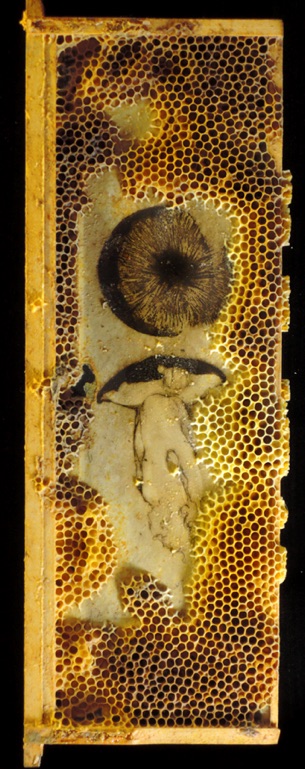
Masaryk and small child Postage Stamp
Etching with aquatint and drypoint
with beeswax added by living bees
Image made from a Czech postage stamp issued in 1938 as a memorial to the recently deceased first president of the Republic, Thomas G. Masaryk. The stamp was also a fund raiser for disadvantaged children and wildly successful. The text reads: Have respect for the soul of a child.
The little girl is my mother, Eva Hanka (Neugebauerová). She was directed to the tribunal by her mother and school principle, where the president was speaking in 1928. Bearing a bouquet of flowers, her memories of the event are primarily of walking through a forest of legs and being pushed along and directed to the elderly gentleman who then hoisted her aloft as she watched a photographer over his shoulder taking their picture. The picture is periodically republished on significant occasions and was even used for wartime posters to give heart to the Czech airman then fighting in the RAF during the battle of Britain. The stamp was reissued in 2000 and remains popular to this day.
This stamp is a sentimental favorite of the philatelic world and involves some truly accomplished engraving by one of the great pre-war Czech engravers, Bohumil Heintz. Mother gets fan mail to this day and from collectors all over the world . She is continually being asked to autograph first day covers and stamps. Recently a Czech film-maker, Jan Rousek, came to Kalamazoo to make a documentary called - ‘’In the Hands of Masaryk’ – a sort of, ‘what ever happened to that cute little girl on the stamp remembrance.’
Content though – think about how long it's been since we all agreed that one of our own statesmen was this beloved – clearly and undeniably working for the common good. Kennedy? Lincoln? Jefferson maybe? Being the president of prewar Czechoslovakia with the Nazis next door growing steadily in power was not an easy task. Stalin made the mix of regional politics no easier nor did Mussolini - add Horty or Pilsudski right next door and a Hapsburg pretender to the Austrian and Hungarian thrones rattling sabers and threatening to invade from time to time? It wasn’t a cake walk. The curse of living in interesting times.
So I remind myself in such small ways of statesmanship as it not only could be, but indeed, occasionally even is. That little three year old girl matured and got tossed about by the vagaries of twentieth century geo-politics, ended up on the shores of America as a refugee and eventually taught various languages and even classics in the Kalamazoo public school system. She is alive and doing well today in Kalamazoo – reading her Cicero, Vergil and Epictetus – depicted as she looks today to the upper right of this text. Honor your sources - eh?
Not for sale - it’s my mother for Christ-sake!

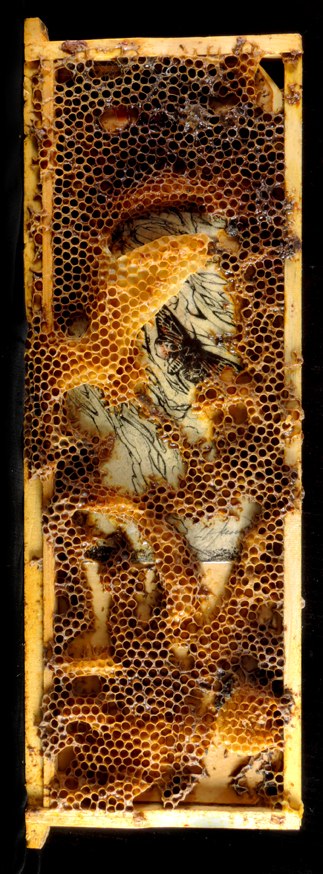
Tiger Moth embalmed
Extracting artwork form the hive
Witch Tree - Little Spirit Cedar - (Manidoo Ghizhi Ganz in Ojibway)
Chantrelle
Peering into the Void - beholding the eye of the beholder
Swallowtail
Bur Oak at Yankee Springs
Elku Liepa, Latvija
Whip Poor Will embalmed
Pileated Woodpecker Embalmed
Million Dollar Oak - Portage MI
Boletus edulis
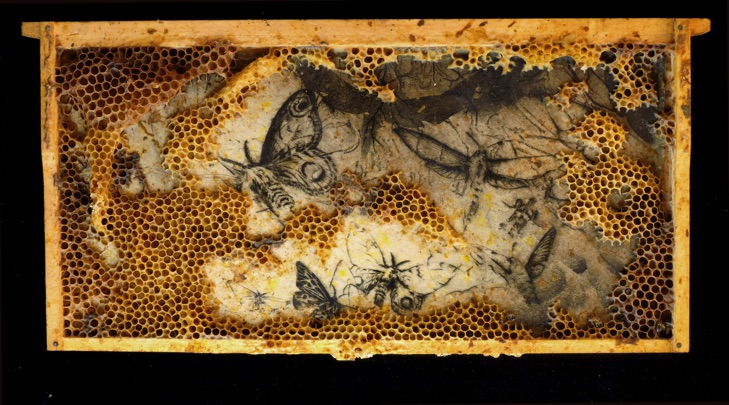
Windblown Dune Beeches : Saugatuck Dunes State Park
Ancient cedar : Silver Island in Lake Superior
Scriptum arborum
Toad
Eva Hanka 2013


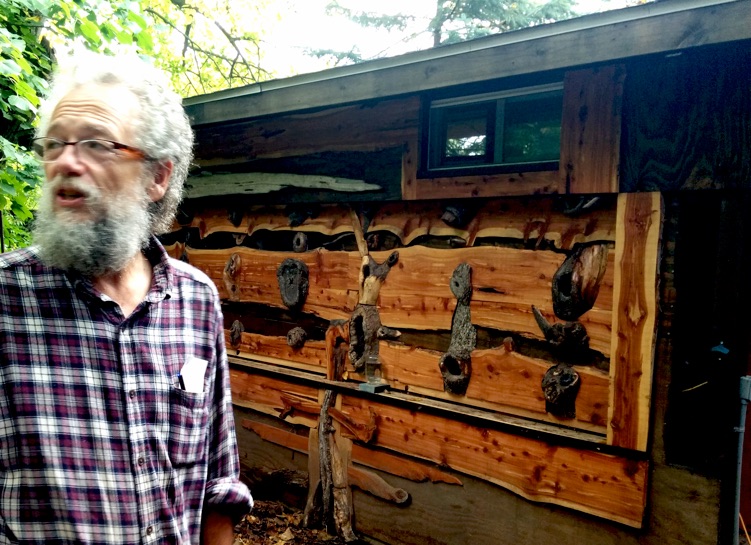
The Book of Toads
Night flying insects
